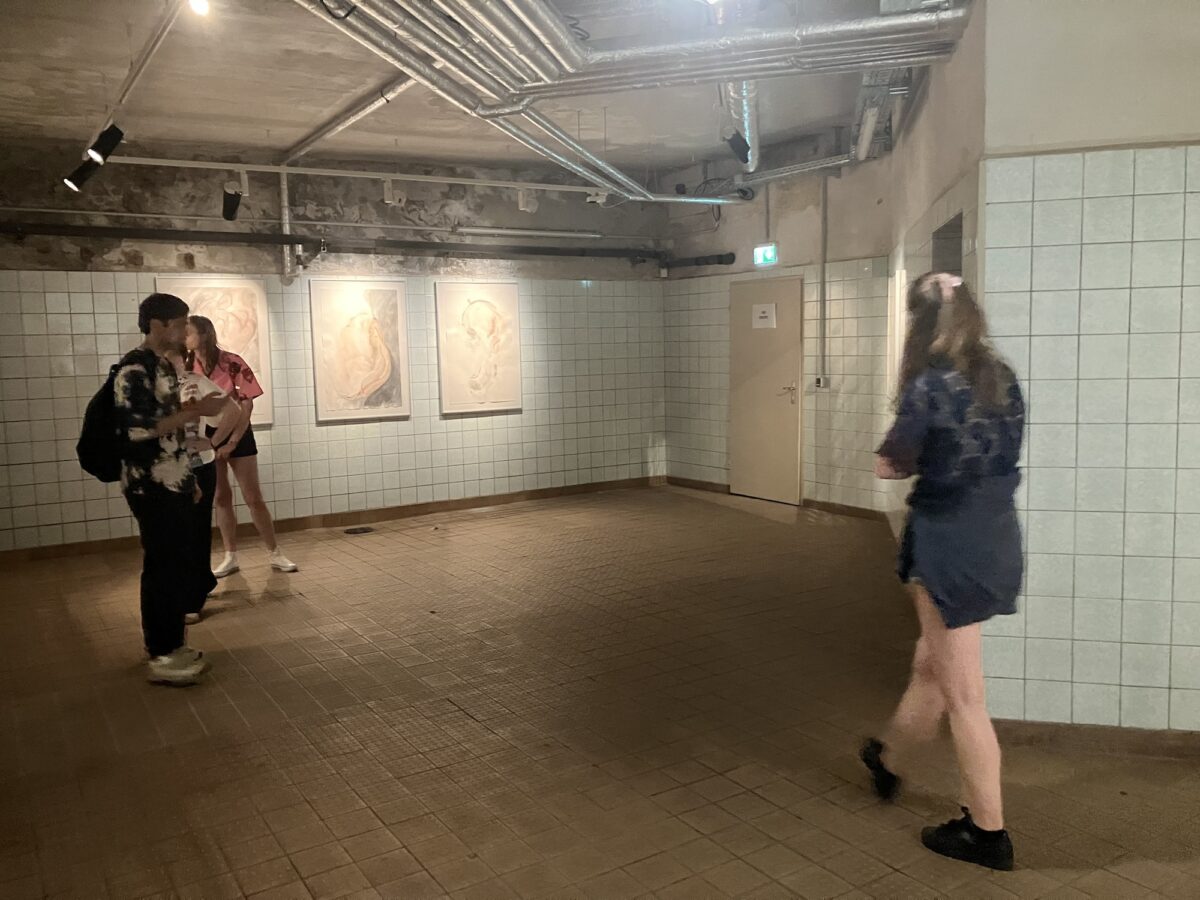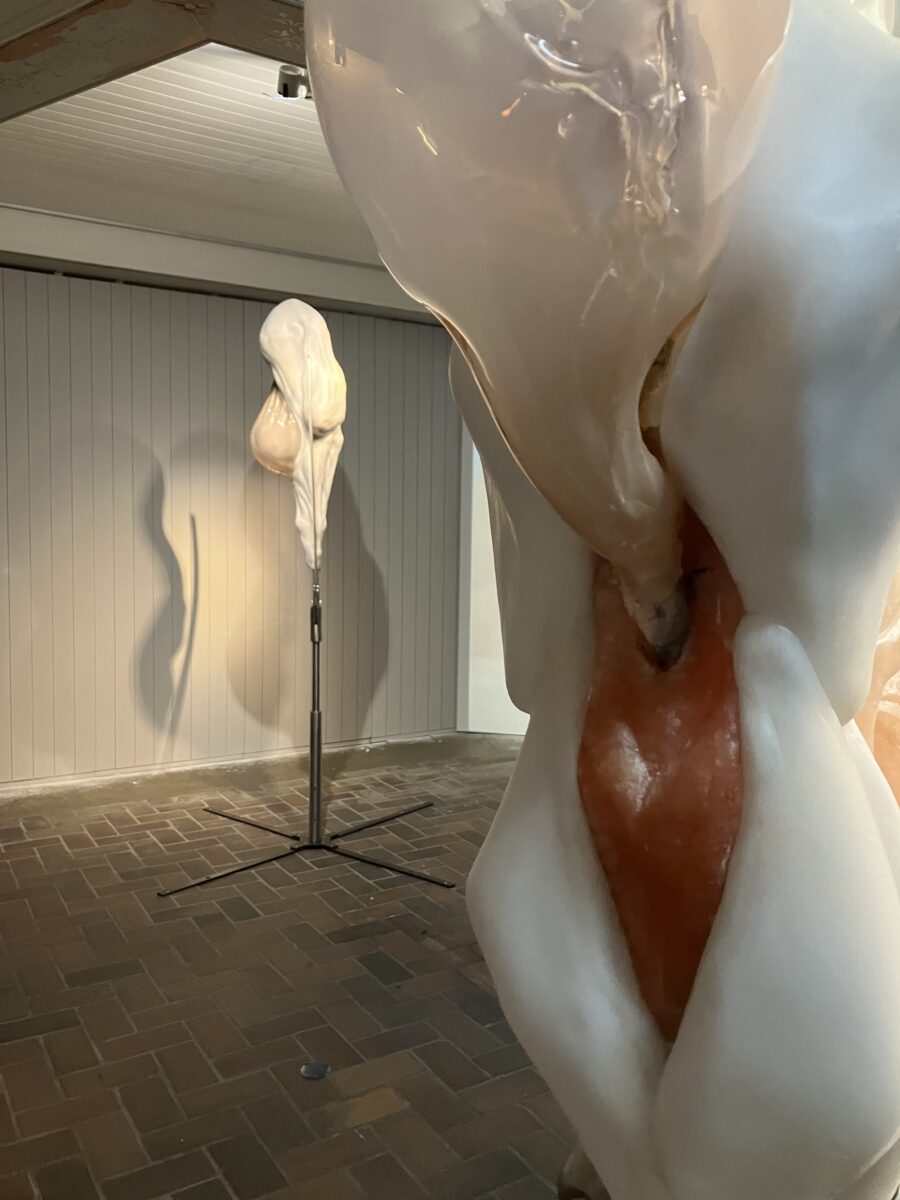Fixed inside a round steel frame about the size of a bicycle wheel, a creamy rose hunk of alabaster is gently but repeatedly hammered by eight blunt mechanical arms. At first glance, the kinetics of Ivana Bašic’s Metabole feel relatively benign. However, since its unveiling in early June, the unrelenting tippity-tap has already rendered a small pile of dust to accumulate around the base of the sculpture — signifying its ultimately ephemeral lifespan. Its monotone soundtrack reverberates throughout the building, interrupted only by the industrious clank of metal on stone.

The New York-based Serbian artist’s first institutional solo exhibition, Metempsychosis: The Passion of Pneumatics, comprises sculptures, drawings, and video spanning two levels and five rooms. This particular site-specific sculpture occupies the entirety of the bowed octagonal cupola on the first floor at Berlin’s Schinkel Pavillon. Airy and panopticon-esque, entering the space feels not unlike happening upon the lofty main deck of a spacecraft, or the DNA archive of a speculative future world.

Fixed at opposite ends of a long steel armature — an element that reoccurs chronically in Bašic’s sculptures — are a pair of animal-like forms whose human size but arthropod-like contours command an aura of epochal staying power: the indestructible cockroach meets Brave New World. These primordial figures are even mounted like insects. Curiously preserved specimens destined for the shadowboxes of a colossal wonder cabinet.
Representations of what the artist describes as post-humanist feminism, the quest for immortality, and intergenerational trauma furnish a space reminiscent of distant crisis. A centring and simultaneously disparate de-centring of the human offers little frame of reference to any kind of century or time period, though.
The bodies’ bulbous nodules are visibly moist but also barrenly dry. Glass, steel, wax, and metal form a material language that is organic yet sterile. Pink, white, and nude tones are reminiscent of blood, bone, and flesh. Cold ribbed, burnished, and polished metal counteracts the sinewy palette in the form of knobbly legs, angular rods, and draped umbilical cords.
Downstairs is a collection of smaller sculptures, each seemingly frozen in time. Walking under a giant four-legged arachnid, the tender exposed torso reveals what look to be its organs. Other works resemble ripe morsels of fruit or the breaching head of a half born baby emerging from the soft folds of its entryway.

A video is projected across the wall of the main room. Haunting swaths of dust swirl through the air, tiny twisters dancing and retreating. Intended to set the tone for the room, the piece is silent, unnamed, and unlabelled, like a ghost with no voice but all the answers.
Even the dust is human-ish, its movements aching for some narrative interpretation — but what one sees in it says as much about the viewer as it does about the artist’s intention — much in the way that hauntology and religion can shape the perception of reality, the meaning of life, or the interpretation of violence, the significance of a swirl of particles may represent the precipice of creation, a phoenix rising, or just weather patterns.

Lending credence to the installation is the eccentricity of the space itself. Between the ornate GDR architecture and careful, restrained restoration, the windowless ground floor interior retains that degenerate shitty chicness of an indie Berlin project space. Floor to ceiling tiles nod to the building’s past as a restaurant, but if you squint past the decorative frescos, it could also be a butchery dungeon or musty fornication chamber, which only adds to the imaginary origin of the unidentified creatures.

In fact, the non-profit contemporary art association is located in the centre of Museum Island: an urban archipelago, UNESCO world heritage site, and museum complex otherwise home to some of the city’s most strait laced institutions. In this way, Schinkel Pavillon itself is an island within an island.

Bašic first made an appearance here last summer as part of the group show Human Is, whose endeavour into post humanism conveyed a similar agenda, that being an evaluation of the anxiety, disorder, and aesthetics of the Anthropocene. Phrases like humanoid, immortality, and prosthetics signal the compulsion not only to expose the human condition, but to elongate, preserve, and warrant the enquiry.
However, instead of grasping onto epistemological foundations, the work feels like the telling of an after-story. Organisms resembling a foetus seem not only to be mature, but well beyond. Perhaps the sculptures do not convey the event of a birth, but of a cryogenic defrost: highly evolved creatures who are not in a state of arrival but a process of transmigration, or rebirthing of themselves.

To that end, the mechanisms explored in the work are universal. While it may be helpful to consider Baši?’s source inspiration, such as Greek and Egyptian lore, political conflict, or various historical and theoretical references, it is not essential. One need not comprehend the meaning of obscure words peppered in the exhibition text, such as hypostasis, gnostic, or chthonic.

Call it pneumatic if you like, but where the words and works converge is in the inflection of breath, which is something that is sooner felt than comprehended. To know that the artist’s own breath is timed to the cadence of the hammers is informative, but not critical. Alternately, I propose that the visitor observe their own breath, how it feels, and how it is arrested or possessed by the interaction with the work. Leave the dictionary at home and take note instead of that elemental thing that makes you human.

IVANA BAŠIC, Metempsychosis: The Passion of Pneumatics – 1st September 2024 Schinkel Pavillon





